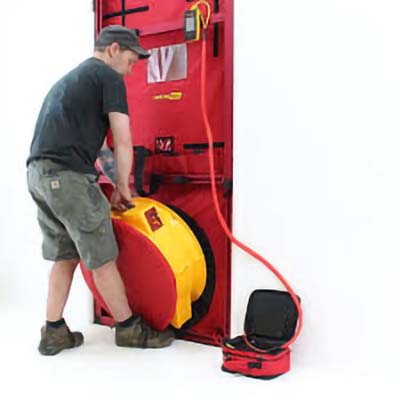Blower Door Test in Castell, TX | Certified Energy Testing
When building a new home or multi-family property in Castell, TX, a blower door test is often necessary to comply with the 2018 International Energy Conservation Code (IECC).
Our expert energy testers, fully certified, provide reliable and precise blower door and duct leakage testing to ensure full compliance with Texas energy codes. We specialize in uncovering air leakage problems that affect energy savings, indoor air quality, and overall heating and cooling costs. Whether you’re a builder, contractor, or homeowner, we offer quick, budget-friendly, and certified blower door testing in Castell, TX, and nearby areas.

What Is a Blower Door Test?
- Energy efficiency – Homes with poor insulation waste energy, leading to costly utility bills.
- Indoor air quality – Air leaks that go unchecked may allow pollutants and allergens inside.
- HVAC performance – Air leakage forces HVAC systems to work harder.
- Comfort levels – Temperature inconsistencies and drafts stem from excessive air leakage.
How Does a Blower Door Test Work?
By attaching a high-capacity fan to an exterior door, a blower door test establishes a pressure differential between a home’s inside and outside. Air infiltration through unsealed gaps, cracks, and leaks is precisely measured with a pressure gauge. A home with too much air leakage may benefit from additional insulation and better air sealing.

Do You Need a Blower Door Test in Castell, TX?
The 2018 IECC regulations state that a blower door test is necessary for all newly built homes in Castell, TX to confirm energy efficiency compliance.
You may also need a blower door test if:
✔ You’re in the process of building a home and must pass an energy compliance test.
✔ Your energy bills are high and you suspect excess air leakage.
✔ You experience drafts, uneven heating, or poor indoor air quality.
✔ You are applying for an energy efficiency rebate or certification.
If your home or project requires a blower door test, we guarantee quick appointments, same-day results, and official energy code certification.

Texas Energy Code Requirements for Blower Door Testing
The 2018 IECC requires homes in Texas to achieve the following air tightness performance levels.
- 3-5 (Air Changes Per Hour at 50 Pascals) depending on location.
- Homes exceeding this air leakage limit may require additional air sealing measures.
When HVAC components, such as an air handler or ductwork, are placed beyond the conditioned space, a duct leakage test becomes necessary.
Our Blower Door Testing Process
Booking a blower door test in Castell, TX, ensures our certified technicians will follow a strict step-by-step procedure for compliance:
Step 1: Preparation
- All windows and doors are securely closed.
- HVAC systems and exhaust fans are turned off.
- A blower door fan is installed in the main entryway.
Step 2: Conducting the Test
- By pulling air out, the blower door fan depressurizes the home to imitate real-life air leakage.
- Advanced monitoring gauges detect air infiltration levels and locate air leaks.
Step 3: Test Report & Certification
- We provide a thorough blower door test report to meet energy code requirements.
- If necessary, we help identify and fix air leaks to ensure your home meets the standards.
Our team guarantees a fast, expert, and stress-free experience to maintain your project’s timeline.

Why Choose Us for Blower Door Testing in Castell, TX
Working with our experts for blower door testing in Castell, TX, means you benefit from:
✔ Certified Energy Experts – Fully licensed and trained professionals.
✔ Fast Scheduling – We work around your project timeline.
✔ Same-Day Results – Receive a certified test report immediately.
✔ Affordable Rates – Competitive pricing with no hidden fees.
✔ Duct Leakage Testing Available – One-stop compliance for all Texas energy codes.

Schedule Your Blower Door Test in Castell, TX Today!
In need of a blower door test in Castell, TX? We streamline the process for your peace of mind. Contact us today to schedule your test and confirm your project aligns with Texas energy codes.



